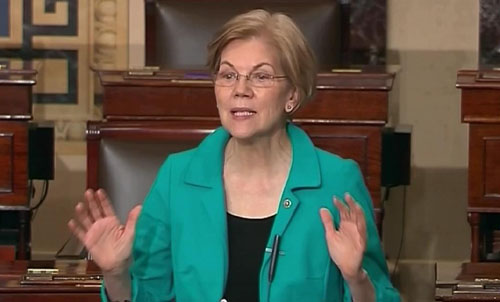by WorldTribune Staff, September 13, 2019
Sen. Elizabeth Warren, whom President Donald Trump often refers to as “Pocahontas”, has long boasted of her Cherokee ancestry and even used it disingenuously to get a leg up in the professional world including a stint as visiting professor at Harvard Law School.
On Aug. 19, Warren told a Native American forum: “Before I go any further in this I want to say this — like anyone who’s been honest with themselves I know I’ve made mistakes. I’m sorry for any harm I’ve caused.”

Historical records show that, not only was Warren’s Cherokee ancestry claim suspect, but that at least one of her ancestors served in a militia which rounded up Cherokees at the beginning of the Trail of Tears.
Warren’s great-great-great grandfather, Jonathan Crawford, served in Major William Lauderdale’s Battalion of Tennessee Volunteer Militia from November 1837 to May 1838, a six month time period during which it fought two battles in Florida against the Seminoles, Breitbart News reported on Sept. 12.
In 1836, Crawford served in the Tennessee Militia that rounded up Cherokees living in Tennessee.
The Seminole Tribe of Florida offers this description of the Second Seminole War in which Warren’s great-great-great grandfather fought against them:
Through the Treaty of Moultrie Creek (1823), the Treaty of Payne’s Landing (1832), and numerous “talks” and meetings, US Indian Agents sought to convince the Florida Indians to sell their cattle and pigs to the US government, return runaway slaves to their “rightful owners,” leave their ancient homelands in Florida, and move west of the Mississippi River to Arkansas Territory. In 1830, soon after Jackson the Indian fighter became Andrew Jackson, the president of the United States, he pushed through Congress an Indian Removal Act. With this Act, the determination of the government to move Indians out of the Southeast and open the land for white settlement became the official policy of the US, and the willingness of the government to spend monies in support of military enforcement of this policy increased.
The clash that inevitably resulted from this policy finally began in 1835, and the seven years that it lasted frame the last, the greatest, and arguably the most tragic years in the history of US-Indian relations east of the Mississippi River. Known to history as the Second Seminole War, the US government committed almost $40,000,000 to the forced removal of slightly more than 3,000 Maskókî men, women, and children from Florida to Oklahoma. This was the only Indian war in US history in which not only the US army but also the US navy and marine corps participated. Together with the desultory Third Seminole War, a series of skirmishes that took place between 1856 and 1858, the United States spent much of the first half of the 19th century in trying, unsuccessfully, to dislodge about 5,000 Seminoles from Florida.
Unlike the “Trail of Tears” that took place in a single, dreadful moment, in 1838, in which several thousand Cherokee people were sent on a death march to the West, the removals of the Seminole people from Florida began earlier and lasted 20 years longer. Just like that other event, however, the toll in human suffering was profound and the stain on the honor of a great nation, the United States, can never be erased. The Seminole people – men, women, and children, were hunted with bloodhounds, rounded up like cattle, and forced onto ships that carried them to New Orleans and up the Mississippi. Together with several hundred of the African ex-slaves who had fought with them, they were then sent overland to Fort Gibson (Arkansas), and on to strange and inhospitable new lands where they were attacked by other tribes, in a fierce competition for the scarce resources that they all needed to survive.
William Lauderdale, the commander of the battalion in which Warren’s ancestor fought, was a close ally of Andrew Jackson.
“Lauderdale was a friend of President Andrew Jackson. The two were neighbors in Tennessee. Jackson asked Lauderdale to take his Tennessee Volunteers to Florida to help in capturing the Seminoles in South Florida to make the area safer for settlers,” the South Florida Sun Sentinel reported in a 1988 article.
Fort Lauderdale historian Cooper Kirk, who has written a biography of Lauderdale, said that after the Seminole wars there were only 299 Indians left in Florida. Before the wars he says there were 4,500 to 4,800. About 4,000 Seminoles were taken to settlements in Oklahoma. Today, 1,700 Seminoles reside in Florida.
Jonathan Crawford mustered out of Lauderdale’s Battalion at New Orleans, Louisiana, in May 1838, and returned to Tennessee. He died there in 1841.
Jonathan Crawford may not have been the only ancestor of Elizabeth Warren who either rounded up or fought Native Americans, the Breitbart report noted.
“Last month Rebecca Nagle, a Native American progressive activist who has been critical of Sen. Warren’s false claims of Native American ancestry and the professional benefit she obtained from making those claims, stated that William Marsh, another great-great-grandfather of Warren, also served in the Tennessee Militia that rounded up Cherokees in 1836,” the report said.
William Marsh’ s daughter, Edith May Marsh, married Jonathan Crawford’s son, Preston H. Crawford. John Houston Crawford, Elizabeth Warren’s great-grandfather, was their son.
Intelligence Brief __________ Replace The Media
